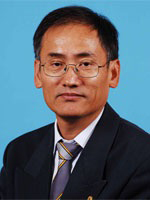 Electrical capacitance tomography and industrial applications
Electrical capacitance tomography and industrial applications
Wuqiang Yang
Electrical and Electronic Engineering, The University of Manchester, United Kingdom
ABSTRACT
As a non-intrusive measurement technique, industrial tomography has been developed for more than 20 years. Among various industrial tomography modalities, such as x-ray, gamma ray, optical, electrical and ultrasonic, electrical capacitance tomography (ECT) is the most mature and has been used for many challenging applications. Now ECT is ready for use in industry for online monitoring, measurement and control. ECT is obviously based on measuring capacitance and reconstructing the permittivity distribution of e.g. a multiphase flow. The internal information obtained by ECT is valuable for understanding complicated phenomena, verifying computational fluid dynamics (CFD) models, measurement and control of complicated processes. Compared with other tomography modalities, ECT has advantages of no radioactive, rapid response, both non-intrusive and non-invasive, withstanding high temperature and high pressure and of low-cost. Because of extremely small capacitance to be measured (down to 0.0001 pF) and the soft-field nature, ECT does present challenges in circuit design, solving the inverse problem and engineering. Our latest AC-based ECT system can generate online images at 300 frames per second with a signal-to-noise ratio (SNR) of 73 dB. Examples of industrial applications include the measurement of gas/oil/water flows, wet gas separation, pneumatic conveyors, cyclone separators and fluidised beds. In this tutorial, ECT will be discussed from principle to industrial applications, together with a demonstration of an AC-ECT system.
AUTHOR BIOGRAPHY
Wuqiang Yang is a Fellow of the IEEE, Fellow of the IET (formerly the IEE) and Fellow of the Institute of Measurement and Control (InstMC). He is currently an IEEE IMS Distinguished Lecturer (2010-2016). Since 1991, he has been working with University of Manchester (formerly UMIST) in the UK and became a professor in the School of Electrical and Electronic Engineering in 2005. He is also a founder and director of ECT Instruments Ltd (www.ect-instruments.co.uk). His main research interests include industrial tomography, especially electrical capacitance tomography (ECT), sensing and data acquisition systems, electronic circuit design, image reconstruction algorithms, instrumentation and multiphase flow measurement. He has published over 300 papers, is a referee for over 40 journals (including 6 IEEE journals), Associate Editor of IEEE Trans. IM, editorial board member of 6 other journals (including Meas. Sci. and Technol.), guest editor of 7 journal special issues and visiting professor at 6 other universities. He received many awards, including the 1997 IEE/NPL Wheatstone Measurement Prize, the 1997 Honeywell Prize from the InstMC, the 2000 IEE Ayrton Premium, 2006 Global Research Award from the Royal Academy of Engineering, and 2009 IET Innovation Award Finalist. He is the General Chairman of I2MTC’2018, which will be held in Manchester. He is one of three Invitation Fellows in the UK awarded by Japanese Society for the promotion of Science (JSPS) in 2015. His biography has been included in Who’s Who in the World since 2002.
